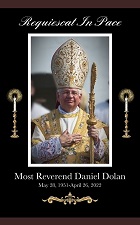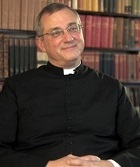One anti-Catholic sect is spreading the idea that the last Pope was Pius IX.
It explains this by the fact that during the reign of Pope Pius IX, the Papal States were dismantled. They say that in this way God "took the Papacy from us."
Let us see if this strange thesis corresponds to the teachings of Holy Scripture and Holy Tradition about the Papacy.
Thesis: “The Last Pope in the line of God's ordained Papacy was Pope Pius IX. Please research the dismantling of the Papal States, which is a direct rejection of the Papacy. So God allowed the Papacy to be removed.”
Response: This thesis is false unambiguously, because it is not confirmed neither by the Holy Scripture nor the Holy Tradition.
In the first place it needs to be said, that this thesis contains a contradiction in itself, since one can conclude that Pope Pius IX was not the last Pope because it was he who was deprived of the Papal States.
If God allowed secular rulers to take away the Papal States from Pius IX, this means that God took the Papacy from him as well. If God took the Papacy from Pius IX, this means that Pius IX was not a Pope. Therefore, the last Pope would have been Gregory XVI, not Pius IX.
Moreover, this thesis contains a false hidden allusion that the Papacy was established first, and then liquidated, not by God, but by man.
From the history of the Catholic Church we know that in 754 A.D., Pepin, King of the Franks endowed the Papacy with the Exarchate of Ravenna that was the real beginning of the Papal States.
If this historical fact is interpreted in the "light" of the above-mentioned thesis, the Papacy first appeared in the 8th century by the will of a man.
And when the Italian Parliament restricted to Pope Pius IX’s sovereign rights to within the borders of the Vatican in 1870, this would mean that the Papacy was taken away by the will of a man as well.
From the Gospel we know something other than what this silly thesis offers us:
"My kingdom is not of this world. If my kingdom were of this world, my servants would certainly strive that I should not be delivered to the Jews: but now my kingdom is not from hence." (St. John 18:36)
“And I say to thee: That thou art Peter; and upon this rock I will build my church, and the gates of hell shall not prevail against it.” (St. Matthew 16:18)
"Feed my lambs. Feed my sheep." (St. John 21: 15-17)
The Vatican Council:
On the Institution of the Apostolic Primacy in Blessed Peter
WE therefore teach and declare that, according to the testimony of the Gospel, the primacy of jurisdiction over the universal Church of God was immediately and directly promised and given to Blessed Peter the Apostle by Christ the Lord. For it was to Simon alone, to whom He had already said: "Thou shalt be called Cephas," (John I, 42) that the Lord, after the confession made by him, saying, "Thou art the Christ, the Son of the living God," addressed these solemn words, "Blessed art thou, Simon, Bar-Jona, because flesh and blood have not revealed it to thee, but My Father, who is in heaven. And I say to thee that thou art Peter, and upon this rock I will build My Church; and the gates of hell shall not prevail against it. And I will give to thee the keys of the kingdom of heaven. And whatsoever thou shalt bind upon earth, it shall be bound also in heaven; and whatsoever thou shalt loose on earth, it shall be loosed also in heaven." (Matthew xvi, 16, 19) And it was upon Simon alone that Jesus after His resurrection bestowed the jurisdiction of Chief Pastor and Ruler over all His fold in the words, "Feed My lambs, feed My sheep." (John xxi, 15, 17) (1)
As the Kingdom of Christ is not limited to the borders of any earthly state, neither is the Papacy limited to the borders of any earthly state.
As the Kingdom of Christ does not depend on temporary well-being or lack thereof, neither does the Papacy depend on temporary well-being or lack thereof.
From its foundation and for its first 300 years the Catholic Church including the Popes was persecuted by pagan authorities. Although the Church and the Papacy did not own land or other real estate, this does not mean that they did not exist.
Since the Church and the Papacy are God's institutions, they have existed from the very moment they were founded by Christ and will continue to exist until the last day of this world, regardless of whether or not they own temples, lands, or states.
Below are a few facts about the history of the Papal States:
"Under the Pagan emperors Christianity was a religio illicita, and the Roman Pontiffs were exposed by their position to the full severity of the laws; a large proportion of them suffered martyrdom. The edicts of Constantine in favour of the religion which he had embraced have been noticed in a previous article [CHURCH PROPERTY, p. 183]. In the middle ages it was long believed that the first Christian emperor had made a solemn "Edict of Donation," conferring on the Pope, Sylvester I., the city of Rome, the imperial palace there, aud the "provinces, places, and cities of all Italy, and the western regions. This donation was long ago recognised as a forgery; Muratori assigns its invention to the eighth century. At the end of the sixth century the Roman See was in possession of large landed estates, chiefly in Italy and Sicily. After the death of Gregory the Great the power of the Eastern Empire in Italy dwindled more and more, and the Lombards, pressing down from the North, threatened to seize upon Rome. Naturally, in the absence of other authority, the Romans and the people of the surrounding districts came to look on the Popes as their protectors and rulers. To drive back the Lombards, Pope Stephen II. appealed for aid to the young Frankish monarchy; Pepin ( 754) crossed the Alps, defeated Astotto, the Lombard king, and endowed the Papacy with the Exarchate of Ravenna. This was the real beginning of the Ecclesiastical State."
"The Holy See was removed to Avignon, and fixed there more than seventy years (1305-1378)."
"The States of the Church remained with their frontiers practically unchanged down to the French Revolution, constituting a territory of irregular shape in the centre of Italy, from Ferrara on the north to Terracina on the south, having Ancona for its eastern and Civita Vecchia for its western seaport. By the treaty of Tolentino (1797) Napoleon compelled the Pope to cede the Legations, Bologna, Ferrara, and Romagna, and admit a French garrison into Ancona; Avignon had been already seized and annexed to France. Subsequently the whole of the Papal territory was appropriated by the French, and when the Pope (Pius VII.) launched against Napoleon on this account the sentence of excommunication, he was arrested and kept a close prisoner, first at Savona and afterwards at Fontainebleau. After the fall of Napoleon, the Pope was reinstated in the government of an undiminished territory. Pius IX., being elected Pope in 1846, proclaimed an amnesty to political offenders, and sincerely endeavoured so thoroughly to reform the administration in every department as to leave his subjects without just cause of discontent. The hateful crime of the murder of his minister Pellegrino Rossi (1848) was the answer of the Roman democrats to the fatherly overtures of the Pontiff. The Pope was compelled to take refuge on Neapolitan territory, and a republic was set up at Rome by Mazzini and Garibaldi. Louis Napoleon, having been elected President of the new French Republic, sent troops to Rome, under General Oudinot, who, without much trouble, drove away the revolutionists and brought the Pope back. All this took place in 1849. A French garrison was left at Rome; but the Pope knew that it did not enter into the designs of Louis Napoleon to defend the entire Pontifical territory; in order, therefore, to keep it intact he raised a small army, commanded by the French General Lamoriciere, and composed to a large extent of foreign Catholics. After the war between Austria and France, in which the power of the former was beaten down at Solferino (1859), Piedmont, ruled by the astute Cavour and assisted by the revolutionary sects, succeeded in obtaining possession of Tuscany, the Legations, Modena, Parma, and Naples. The small Papal army was overpowered by a Piedmontese force many times more numerous at Casteltidardo (1860). The Pope was now left with only one province, the "Patrimony of St. Peter," extending some fifty miles along the coast to the north of Rome. Of this also, and of his capital, Pius IX was deprived in 1870 by the Piedmontese king, who took advantage of the reverses suffered by France in the war with Germany to set at naught the treaty of 1864, by which he nad agreed that Florence should be the capital of the Italian kingdom. It was now said that Rome was the indispensable capital of that kingdom, but that the Pope's independence should be respected. The Papal palace of the Quirinal and all the public buildings of Home were appropriated by the invaders; but the Vatican was left unassailed, and a "Law of Guarantees," passed by the Italian Parliament (and capable of being repealed by the same authority), while assigning to the Pope an annual dotation of two million lire, guaranteed to him sovereign rights within the limits of the Vatican. It is scarcely necessary to say that the dotation has not been accepted, while the fragment of sovereignty guaranteed has already been encroached upon in various ways, and is held on a tenure of the most precarious description. For the present, Rome and the Papal States are lost to the Papacy." (2)
Although Rome and the Papal States are lost to the Papacy, the Papacy itself is not lost but is still alive.
Therefore, the thesis, which claims that the Papacy ceased to exist with the dismantling of the Papal States, is a FALSE thesis.
Fr. Valerii
References:
The quotes from the Holy Scripture taken from: THE HOLY BIBLE PUBLISHED WITH THE APPROBATION OF THE CATHOLIC ARCHBISHOPS AND BISHOPS OF IRELAND. The Douay Version of the Old Testament of 1609, and with the Rhemish Version of the New Testament of 1582, Given at Dublin, May 4th, 1857.
(1) THE DECREES OF THE VATICAN COUNCIL
Edited WITH AN INTRODUCTION
by the REV. VINCENT McNABB, O.P.
NEW YORK, CINCINNATI, CHICAGO
BENZIGER BROTHERS Printers to the Holy Apostolic See 1907
Imprimi potest FR LAURENTIUS SHAPCOTE, O.P., S.T.L. Prior Provincialis
Imprimi potest + GULIELMUS Episcopus Arindelensis Virarius Generalis
Westmonasteril die 19 Oct. 1906
First Dogmatic Constitution on the Church of Christ. pp. 36-39
(2) A CATHOLIC DICTIONARY
CONTAINING SOME ACCOUNT OF THE
DOCTRINE, DISCIPLINE, RITES, CEREMONIES,
COUNCILS, AND RELIGIOUS ORDERS OF
THE CATHOLIC CHURCH
BY WILLIAM E. ADDIS
SECULAR PRIEST : SOMETIME FELLOW OP THE ROYAL UNIVERSITY OF IRELAND
AND THOMAS ARNOLD, M.A.
FELLOW OF THE SAME UNIVERSITY
SIXTH EDITION, WITH ADDITIONS.
NEW YORK
THE CATHOLIC PUBLICATION SOCIETY CO.
9 BARCLAY STREET
1887
NlHIL OBSTAT: EDUARDUS S. KEOGH, CONG. ORAT., CENSOR DEPUTATUS
IMPRIMATUR: HENRICUS EDUARDUS, CARD. ARCHIEP. WESTMONAST. Die 18 Dec., 1883.
IMPRIMATUR: JOHN CARD. McCLOSKEY, ARCHBISHOP OF NEW YORK. Feb. 14, 1884.
JURISDICTION
pp. 772-774
|

